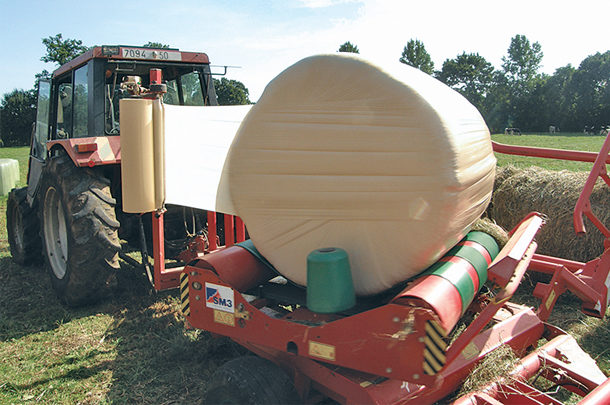The result is silage covers and wraps intended to render oxygen impermeable and bacterial science that seeks strain combinations that work to reduce spoilage micro-organisms and encourage robust fermentation, along with developments in the bale-wrapping process that increase bale densities.
No excuse for poor harvest management
Every farm should follow a set of established and proven best practices. There really isn’t an excuse for poor harvest management given the abundant information available.
However, weather, labour and equipment are all factors that can either support or hinder the ability to make bales of high-quality silage. Year after year, producers looking to shave a bit from the expense column of the farm ledger try to cheat oxygen contamination by selecting low-cost, standard plastic covers and avoiding the use of bacterial inoculants.
The negative results of such decisions are sometimes quite obvious, with mold, mildew and unpalatable silage creating waste. Other times the negative results are not quite as obvious, like lower nutrient retention, higher-than-palatable butyric and acetic acid levels, shrink and reduced digestibility.
Good harvest management is indispensable, so before harvest, be sure all equipment is functioning, storage locations are determined and inoculants and oxygen-barrier film are on hand.
Optimal moisture and harvest of baled silage
One of the distinct advantages of baled silage is that the harvest time from cut to bale is short, and in warm weather this can often be just a matter of hours. Therefore, it is recommended not to cut more crop than can be harvested within a reasonable window of time given labour and equipment availability.
In warm or windy weather conditions, the quickness of wilt also means the producer needs to be ready for baling and sealing as soon as conditions allow.
Moisture content at ensiling is critical, with optimal levels for legumes like alfalfa determined to be from 45 to 55 percent. Moisture balance must be maintained since high enough levels are required for compaction and oxygen displacement and a complete fermentation, but at the same time excessive moisture can lead to spoilage issues.
Within these levels, however, optimal fermentation is facilitated. Be sure to measure the moisture level of the crop and not rain or dew. In fact, excessive non-plant moisture may hasten mold or mildew development. Baling, wrapping and storing bales at optimal moisture levels require well-coordinated operations and preparedness.
Encouraging thorough fermentation
Whether storing silage in bunkers, piles or bales, quickly lowering the pH, establishing thorough fermentation and restricting oxygen are three undisputed factors in achieving high-quality results.
Bales also offer a particular challenge since surface area is abundant with half of the silage inside the bale being within 5 inches of the surface. This allows for more capacity for oxygen degradation and the challenge of quickly achieving an anaerobic (no oxygen) environment and successful fermentation.
An anaerobic environment is required for the fermentation of sugars to organic acids. Organic acids such as lactic acid lower the pH, help inhibit undesirable organisms and stabilize the forage. If fermentable sugars are not available before the pH is low enough, spoilage clostridia bacteria can prosper, then break down lactic acid and protein to other undesirable components.
Baled silage requires a lot of care, especially if the crop contains a high amount of legumes like alfalfa. Alfalfa may not have enough concentration of carbohydrates for optimal fermentation by lactic acid bacteria, and the high protein content buffers and hampers the fall in pH. Research has shown that chopped alfalfa contains about 10 times the amount of lactic acid bacteria over unchopped.
Unchopped alfalfa silage has also been shown to have higher ethanol levels, which are common with slow fermentation due to inefficient natural lactic acid bacteria. In fact, in this condition, protein can also be degraded.
In addition, alfalfa may be lacking available sugars and as a result may not – on its own – have the ability to adequately ferment. In this event, supplementing with efficient bacteria that produce lactic acid can help fermentation by increasing lactic acid bacteria concentrations. Quality bacterial silage inoculants should contain a guaranteed analysis with a minimum of 105 colony-forming units.
Use a lactobacillus bacteria inoculant to improve fermentation, particularly in alfalfa. Agriculture and Agri-Food Canada research has shown this type of inoculant can improve livestock intake by 5 percent and daily weight gain by 11.6 percent.
Firm, dense bales that are tightly wrapped encourage a quicker evolution from an aerobic to anaerobic state, thus promoting a quicker drop in pH and more rapid fermentation.
Depending on harvest time of year and harvest conditions, complete fermentation can take between two and four weeks when bales enter a stable state, when further fermentation is no longer possible.
Wrapping and storing bales
As mentioned, oxygen is the enemy of quality silage, so it is highly recommended to invest in high-quality oxygen-barrier film that will cling tightly to the bales and is proven to reduce or restrict oxygen penetration.
This way, bales are well sealed, a rapid anaerobic environment is encouraged, and bales are protected during storage. Producers should carefully select wrapping material and look for material specifically proven to withstand sun damage and inhibit oxygen penetration.
Most plastic films for stretch-wrap silage are co-extruded, linear low-density polyethylene that are 1 mil thick before being stretched between 55 percent (square bales) and 70 percent (round bales) in hot weather during application.
This lower density causes these polyethylene films to be relatively permeable to oxygen and other gases. To create a better oxygen barrier, typical plastics are often wrapped around the bale with as many as eight to 10 layers. While this helps prevent oxygen contamination, this practice can be time, labour and materials cost-prohibitive – even if initial plastic cost is reasonably low.
As an alternative, oxygen-barrier films are specifically engineered to be impermeable to oxygen intrusion and require fewer wrap layers (typically four to six), and this is mostly to prevent puncture holes during transport and storage.
For example, Table 1 shows various comparisons of polyethylene plastic versus oxygen-barrier film.

It should be noted that with fewer layers of wrap, however, producers should take extra caution with bale handling and storage.
Finally, be sure that any puncture holes are sealed over quickly to reduce spoilage and opportunity for pests.
The ‘wrap’ up
Baled silage – especially alfalfa – presents dairy producers with unique opportunities and challenges. Advanced preparation in addressing these challenges ahead of harvest time is part of good management and can be supported with quality bacterial inoculants and oxygen-barrier film. Combined, this becomes an unbeatable protocol for putting up high-quality baled silage. PD
Steve Graham is a technical consultant with MojoMoo. Email Steve Graham.
PHOTO: Firm, dense bales that are tightly wrapped encourage a quicker evolution from an aerobic to anaerobic state, thus promoting a quicker drop in pH and more rapid fermentation. Photo provided by MojoMoo.

-
Tom Chamberlain
- Technical Advisor
- Silostop
- Email Tom Chamberlain











